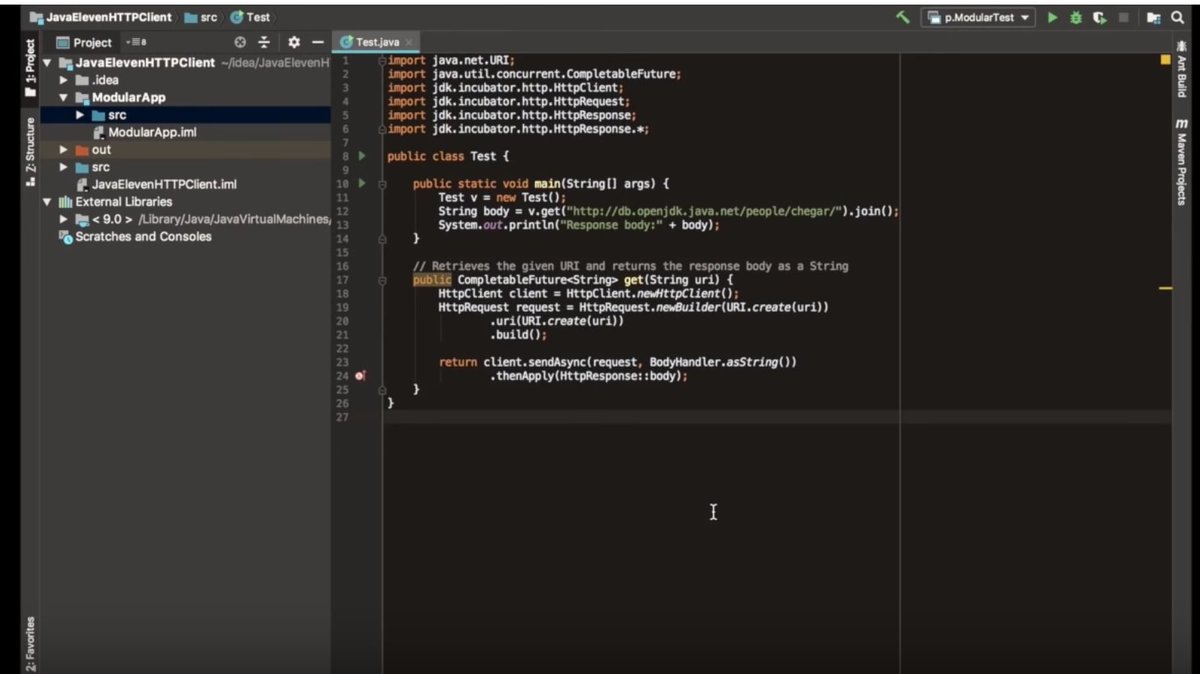
I think `Path.of` is preferred to `Paths.
Java 11 http client code#
Too many lines of code for such a simple thing. "It is recommended to obtain a Path via the Path.of methods instead of via the get methods defined in this class as this class may be depreca Simplifier wrote: Once an HttpResponse is received, the headers, response code, and body (typically) are available.

It is recommended to use instead of other HTTP Client APIs like Apache Http Client API. This API is the recommended alternative to URLConnection API. The API supports both HTTP 1.1 and HTTP 2. This API provides non-blocking request and response semantics through CompletableFuture. Java 11 standardizes this API (package ). An HttpClient is created through a builder. Java 9 introduced HTTP Client as an incubating API (package ). An HttpClient can be used to send requests and retrieve their responses.
Java 11 http client how to#
The BodyHandler determines how to handle the response body, if any. With Java 11, now HttpClient is a standard. HttpClient (Java SE 11 & JDK 11 ) Module Package Class HttpClient public abstract class HttpClient extends Object An HTTP Client. A BodyHandler must be supplied for each HttpRequest sent. Try (InputStream inputStream = ("test.fil Christian Stein wrote: An HttpClient provides configuration information, and resource sharing, for all requests sent through it. Reinersdorff wrote:Īn option without hardcoding src/test/resources: The activemq-cli is a great tool for testing JMX on the local server.

How could something so simple as a bunch of characters repr David Kant wrote: I know several people are Kevin Farnham wrote:Īmazingly, strings are a problem throughout so many languages, C, C++, Java, Python. Is Netbeans even used anymore (outside of Oracle or their non-IT customers)? The change was implemented as a part of JEP 321. It aims to replace the legacy HttpUrlConnection class which has been present in the JDK since the very early years of Java. I've download the mocked project and launch the Ananth Raghuraman wrote: The major change in Java 11 was the standardization of HTTP client API that implements HTTP/2 and Web Socket. I've tried what you have done in your video, but no test was executed.

This session will first provide the background to the. Only this little change was Aldo Lushkja wrote: The new HTTP Client API, incubated in JDK 9, re-incubated in JDK 10, has been standardized in Java SE 11.
Java 11 http client tv#
HttpResponse response = nsumeHttpPostFormUrlEncodedClientByRequestUrl(Constants.URL_BASE + Constants.Thanks Adam to you reply on 88th Airhacks TV to this question, migrating to Quarkus 2+ version solved the issue. Java 11 comes with a nice HttpClient API/Implementation so that we no longer need to rely on external libraries like Apache HttpClient execute http requests. URLEncoder.encode(entry.getValue(), StandardCharsets.UTF_8)) URLEncoder.encode(entry.getKey(), StandardCharsets.UTF_8), Recently we had a requirement of setting an authentication. It supports HTTP/1.1 and HTTP/2, both synchronous and asynchronous programming models, handles request and response bodies as reactive-streams, and follows the familiar builder pattern. It can be used to request HTTP resources over the network. Prior to Java 11, developers had to use URLConnection to send HTTP requests. As Łukasz Olszewski said, worked correctly : String params = Map.of(Ĭonstants.PARAM_CLIENT_ID, apiObject.getClientId(),Ĭonstants.PARAM_SCOPE, apiObject.getScope(),Ĭonstants.PARAM_CODE, apiObject.getCode(),Ĭonstants.PARAM_REDIRECT_URI, apiObject.getRedirectUri(),Ĭonstants.PARAM_GRANT_TYPE, apiObject.getGrantType(),Ĭonstants.PARAM_CODE_VERIFIER, apiObject.getCodeVerifier()) The HTTP Client was introduced in Java 11.


 0 kommentar(er)
0 kommentar(er)
